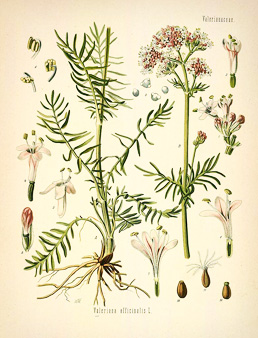Vaunted Valerian
By Audrey Stallsmith

O’er marum [marjoram] borders, and valerian bed,
Thy Selina [cat] shall bend her moping head,
Sigh that no more she climbs, with grateful glee,
Thy downy sofa, and thy cradling knee.
“An Old Cat’s Dying Soliloquy” by Anna Seward
If all those bills from Christmas are causing you sleepless nights, you may want to try valerian (Valeriana officinalis). One of the few medicinal herbs still widely used in modern society, it reportedly has sedative qualities, but doesn’t cause side effects if taken in the recommended amounts.
Before you plant valerian in your garden, however, take into account the effect it is likely to have on the local animal population. The herb’s crushed foliage or roots—both of which smell unpleasantly like dirty socks to us humans—are ambrosia to cats and can drive them as crazy as catnip does. Since each lanky plant makes only one upright stem, which grows from 3 to 5 feet tall with ferny leaves, it easily can be crushed by felines rolling on it.
The scent of the small white flowers, produced in pink or red-tinged umbels throughout the summer, is—according to Mrs. Grieve’s A Modern Herbal--“somewhat peculiar, but not exactly unpleasant.” In The Fragrant Path, Lousie Beebe Wilder notes that “Valeriana officinalis scents all the garden with its heliotrope-like breath, but it is one of the odors into which one should not probe too deeply. Catch it from the breeze and it is delicious, but draw too near and one is conscious of an underlying unpleasantness, a faint fetidness.”
Perhaps that explains why rats also are attracted to the herb, which folklore holds is what the Pied Piper used to lure those rodents out of Hamlin. Of course, if the cats and rats arrive in your garden at the same time, the former might cancel out the latter, provided the felines aren’t too “high” to hunt!
Valerian spreads via root runners and those roots usually are the part of the plant used medicinally. It originally was called phu (the ancient equivalent of phew!) due to its odor--or garden heliotrope due to its flowers’ scent.
Its genus name derives from the Latin valere (“to be in health’), as the herb once was considered a cure-all. (Keep in mind that the plant used medicinally is different than the garden flower sometimes known as red valerian, which actually belongs to the genus Centranthus.)
In addition to promoting sleep, Valeriana officinalis also relieves headaches and digestive cramps. It stands for “an obliging disposition” in the Language of Flowers, probably because it can turn irritable sleep-deprived persons into more agreeable ones!
Folklore held that it also can prevent wars and other unpleasant conflicts by soothing the combatants into a more peaceful frame of mind. Maybe it even could cause a temporary detente between the cats and the rats!
The Valeriana officinalis image is from Kohler's Medizinal Pflanzen, courtesy of plantillustrations.org.








